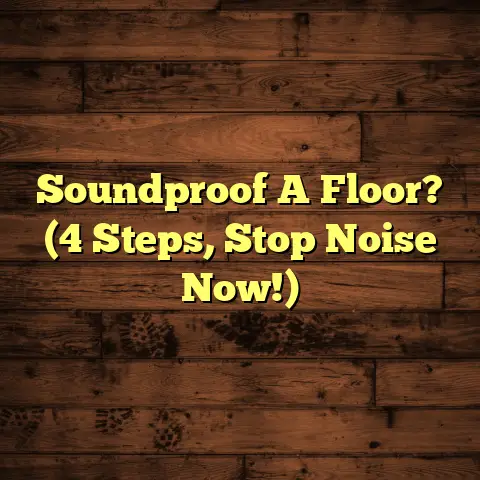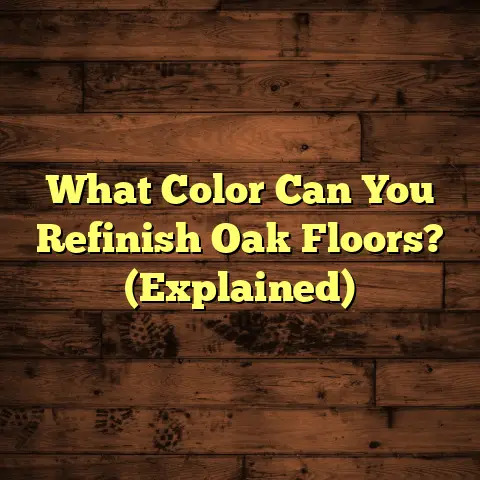Remove Black Spots From Wood? (2-Step Fix!)
What if you walked into your living room one day to find unsightly black spots marring the beauty of your beloved hardwood floor?
These dark stains, often caused by moisture or mold, can feel like a nightmare for any homeowner.
But what if I told you that there’s a simple two-step fix to restore your wood surfaces to their former glory?
I’ve been a flooring contractor for over 15 years, and I’ve seen it all – from minor scratches to major water damage.
Black spots are a common issue, and thankfully, they’re often treatable. Let’s dive in and get your wood looking its best again!
1. Understanding the Cause of Black Spots on Wood
So, what exactly are these black spots?
Essentially, they’re a discoloration of the wood, usually caused by moisture. This moisture creates the perfect environment for mold and mildew to thrive.
Think of it like this: wood is porous, meaning it has tiny little holes. When water gets in, especially if it sits there for a while, it can penetrate deep into the wood fibers.
This dampness, combined with warmth and lack of airflow, is like throwing a party for mold spores. And believe me, they’ll RSVP!
How They Typically Form:
- Moisture Exposure: Leaks (even small ones!), spills that aren’t cleaned up quickly, and high humidity can all contribute.
- Mildew: This is a surface fungus that often appears as a fuzzy, grayish-black coating.
- Mold: A more serious issue, mold can penetrate deeper into the wood and cause structural damage if left untreated.
Now, some types of wood are definitely more susceptible to staining than others. Softer woods like pine are generally more porous and absorb moisture more readily than hardwoods like oak or maple.
Here’s a quick breakdown:
| Wood Type | Susceptibility to Black Spots |
|---|---|
| Pine | High |
| Fir | High |
| Oak | Medium |
| Maple | Medium |
| Cherry | Low |
| Walnut | Low |
Environmental factors also play a big role. If you live in a humid climate, or if your home has poor ventilation, you’re more likely to experience black spots on your wood surfaces.
I remember one time, I was called out to a home in Florida where the homeowner was absolutely distraught.
She had beautiful, newly installed pine floors, and within a few months, they were covered in black spots.
Turns out, she loved to keep her windows open, and the constant humidity from the nearby ocean was wreaking havoc on her floors.
She was so upset, saying “I feel like all my money is going to waste!”
We were able to clean and seal the floors, and I advised her to invest in a dehumidifier. It made a world of difference!
2. The Importance of Addressing Black Spots Promptly
Okay, so you’ve got some black spots. It’s tempting to ignore them, right?
Maybe cover them with a rug? Trust me, that’s the worst thing you can do!
Addressing black spots promptly is crucial for several reasons. First and foremost, they can spread like wildfire.
What starts as a small spot can quickly grow and affect a larger area of your wood surface. The longer you wait, the more difficult (and expensive!) it will be to fix.
Imagine a tiny water leak under your sink. If you catch it early, you can simply tighten a pipe. But if you let it go, it could lead to extensive water damage, mold growth, and even structural issues. Black spots are the same way.
Beyond the aesthetic concerns, there are also potential health implications associated with mold and mildew.
These fungi can release spores into the air, which can trigger allergic reactions, asthma symptoms, and other respiratory problems.
According to the EPA, mold exposure can cause:
- Nasal stuffiness
- Throat irritation
- Coughing or wheezing
- Eye irritation
- Skin irritation
(Source: EPA – Mold)
Creating a clean and safe living environment is essential for your well-being, and that includes addressing any mold or mildew issues promptly.
And let’s not forget about the value of your home! Well-maintained wood surfaces are a major selling point.
According to a 2023 study by the National Association of Realtors, homes with hardwood floors sell for an average of 2.5% more than homes with other types of flooring.
(Source: National Association of Realtors)
Nobody wants to walk into a house and see unsightly black spots on the floors or walls. It gives the impression that the home is not well-cared for, which can negatively impact its value.
3. The 2-Step Fix for Removing Black Spots from Wood
Alright, let’s get down to business! Here’s my tried-and-true two-step fix for removing black spots from wood:
Step 1: Preparation and Materials Needed
Before you start cleaning, it’s important to gather your supplies and prepare the area properly. This will ensure that you have everything you need and that you’re working in a safe and efficient manner.
Materials You’ll Need:
- Cleaning Agent: (Choose one from the options
below – I’ll explain them in more detail later)
- White vinegar
- Baking soda
- Hydrogen peroxide
- Commercial wood cleaner (specifically designed for mold/mildew removal)
- Protective Gear:
- Gloves (to protect your hands from the cleaning solutions)
- Eye protection (goggles or safety glasses)
- Mask (especially if you’re dealing with mold)
- Tools:
- Soft cloths or sponges
- Soft-bristled brush (an old toothbrush works well for small spots)
- Spray bottle (if using a liquid cleaner)
- Sandpaper (fine-grit, for stubborn stains)
- Vacuum cleaner with a hose attachment
- Optional:
- Wood sealant or finish (to protect the wood after cleaning)
Preparing the Area:
- Remove Furniture: Clear the area of any furniture, rugs, or other items that might get in the way.
- Ventilation: Open windows and doors to ensure proper ventilation. This is especially important when working with cleaning solutions, as some of them can have strong fumes.
- Vacuum: Use a vacuum cleaner with a hose attachment to remove any loose dirt, dust, or debris from the area.
-
Test the Cleaning Solution: Before applying any cleaning solution to the entire area, test it on a small, inconspicuous spot. This will help you ensure that the solution doesn’t damage or discolor the wood.
- Apply a small amount of the cleaning solution to the test area.
- Let it sit for a few minutes.
- Wipe it away with a clean cloth.
- Check for any signs of damage or discoloration.
If the cleaning solution doesn’t cause any problems, you can proceed with cleaning the entire area.
I can’t stress this enough: always test your cleaning solution first!
I once had a client who decided to skip this step and ended up bleaching a large section of her beautiful cherry wood floor. It was a costly mistake!
Step 2: The Cleaning Process
Now that you’ve gathered your supplies and prepared the area, it’s time to tackle those black spots! Here’s a step-by-step guide for treating them:
-
Choose Your Cleaning Solution:
-
White Vinegar: A natural disinfectant and deodorizer. Mix equal parts white vinegar and water in a spray bottle.
-
Baking Soda: A mild abrasive that can help remove surface stains. Make a paste of baking soda and water.
-
Hydrogen Peroxide: A bleaching agent that can help lighten dark stains. Use a 3% solution.
-
Commercial Wood Cleaner: Look for a cleaner specifically designed for mold and mildew removal. Follow the manufacturer’s instructions carefully.
-
-
Apply the Cleaning Solution:
- For Surface Stains: Spray or apply the cleaning solution to the affected area. Let it sit for a few minutes to penetrate the stain.
- For Deeper Stains: Apply a generous amount of the cleaning solution to the affected area. Cover it with a damp cloth or paper towel to keep it moist. Let it sit for several hours or overnight.
-
Scrub or Buff:
- For Surface Stains: Use a soft cloth or sponge to gently scrub the affected area. Work in a circular motion.
- For Deeper Stains: Use a soft-bristled brush (like an old toothbrush) to scrub the affected area. Be careful not to scrub too hard, as this could damage the wood.
-
Rinse and Dry:
- Rinse the cleaned area with clean water.
- Dry the area thoroughly with a clean cloth.
-
Sand (If Necessary):
- If the stain is still visible after cleaning, you may need to lightly sand the area with fine-grit sandpaper.
- Sand in the direction of the wood grain.
- Be careful not to sand too much, as this could damage the wood.
-
Repeat (If Necessary):
- If the stain is particularly stubborn, you may need to repeat the cleaning process several times.
Important Tips:
- Ventilation is Key: Make sure the area is well-ventilated while you’re cleaning.
- Don’t Over-Saturate: Avoid getting the wood too wet, as this could cause further damage.
- Be Patient: Removing black spots can take time and effort. Don’t get discouraged if you don’t see results immediately.
I’ve found that a combination of baking soda paste and a soft-bristled brush often works wonders on surface stains.
For deeper stains, hydrogen peroxide can be very effective, but be sure to use it sparingly and test it in an inconspicuous area first.
One time, I was working on a project where a homeowner had spilled red wine on her oak floor.
The wine had soaked deep into the wood, leaving a dark, unsightly stain.
I tried everything – vinegar, baking soda, even a commercial stain remover. Nothing seemed to work!
Finally, I decided to try hydrogen peroxide. I applied it to the stain, covered it with a damp cloth, and let it sit overnight.
The next morning, I was amazed to see that the stain had almost completely disappeared!
It just goes to show that sometimes, you have to experiment to find the right solution.
4. Aftercare and Prevention Tips
Okay, you’ve successfully removed the black spots! Congratulations!
But your work isn’t quite done yet. It’s important to take steps to protect your wood surfaces and prevent future occurrences of black spots.
Sealing and Protecting:
After cleaning, it’s a good idea to seal or finish the wood to protect it from moisture and other damage.
- Wood Sealant: A sealant will create a protective barrier on the surface of the wood, preventing moisture from penetrating.
- Wood Finish: A finish will provide a durable and attractive coating that can protect the wood from scratches, stains, and other wear and tear.
Choose a sealant or finish that is appropriate for the type of wood you have and the level of protection you need.
Maintaining Humidity Levels:
As I mentioned earlier, high humidity can contribute to the growth of mold and mildew.
Here are some tips for maintaining humidity levels in your home:
- Use a Dehumidifier: A dehumidifier can help remove excess moisture from the air.
- Improve Ventilation: Make sure your home is well-ventilated by opening windows and doors or using fans.
- Fix Leaks Promptly: Repair any leaks in your roof, plumbing, or windows as soon as possible.
- Use Exhaust Fans: Use exhaust fans in your kitchen and bathrooms to remove moisture from the air.
Regular Maintenance Practices:
Regular maintenance can help keep your wood surfaces looking pristine and prevent the growth of mold and mildew.
- Clean Regularly: Wipe up spills immediately and clean your wood surfaces regularly with a damp cloth.
- Avoid Harsh Cleaners: Avoid using harsh cleaners or abrasive materials, as these can damage the wood.
- Protect from Sunlight: Protect your wood surfaces from direct sunlight, as this can cause them to fade or discolor.
I always tell my clients that prevention is key. By taking a few simple steps, you can protect your wood surfaces and keep them looking their best for years to come.
Conclusion
So, there you have it – my two-step fix for removing black spots from wood. It’s a simple and effective way to restore your wood surfaces to their former glory.
Remember, the key is to act quickly and address the problem as soon as you notice it. The longer you wait, the more difficult it will be to fix.
And don’t forget to take steps to prevent future occurrences by maintaining humidity levels, sealing your wood surfaces, and cleaning regularly.
Well-maintained wood can bring beauty and warmth to your home, and it’s worth the effort to keep it looking its best.
Call-to-Action
Now, I want to hear from you! Have you ever dealt with black spots on wood? What challenges did you face? What solutions did you try?
Share your success stories or ask questions about your own wood care challenges in the comments below. Let’s create a community of support and help each other keep our wood surfaces looking beautiful!





